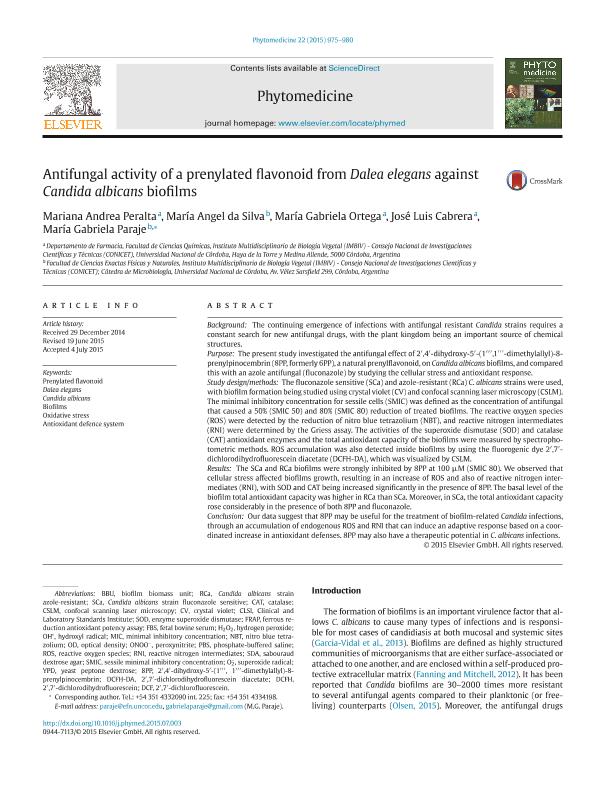Artículo
Antifungal activity of a prenylated flavonoid from Dalea elegans against Candida albicans biofilms
Peralta, Mariana Andrea ; da Silva, María Angel; Ortega, María Gabriela
; da Silva, María Angel; Ortega, María Gabriela ; Cabrera, Jose Luis
; Cabrera, Jose Luis ; Paraje, Maria Gabriela
; Paraje, Maria Gabriela
 ; da Silva, María Angel; Ortega, María Gabriela
; da Silva, María Angel; Ortega, María Gabriela ; Cabrera, Jose Luis
; Cabrera, Jose Luis ; Paraje, Maria Gabriela
; Paraje, Maria Gabriela
Fecha de publicación:
09/2015
Editorial:
Elsevier Gmbh
Revista:
Phytomedicine
ISSN:
0944-7113
Idioma:
Inglés
Tipo de recurso:
Artículo publicado
Clasificación temática:
Resumen
Background
The continuing emergence of infections with antifungal resistant Candida strains requires a constant search for new antifungal drugs, with the plant kingdom being an important source of chemical structures.
Purpose
The present study investigated the antifungal effect of 2′,4′-dihydroxy-5′-(1′′′,1′′′-dimethylallyl)-8-prenylpinocembrin (8PP, formerly 6PP), a natural prenylflavonoid, on Candida albicans biofilms, and compared this with an azole antifungal (fluconazole) by studying the cellular stress and antioxidant response.
Study design/methods
The fluconazole sensitive (SCa) and azole-resistant (RCa) C. albicans strains were used, with biofilm formation being studied using crystal violet (CV) and confocal scanning laser microscopy (CSLM). The minimal inhibitory concentration for sessile cells (SMIC) was defined as the concentration of antifungal that caused a 50% (SMIC 50) and 80% (SMIC 80) reduction of treated biofilms. The reactive oxygen species (ROS) were detected by the reduction of nitro blue tetrazolium (NBT), and reactive nitrogen intermediates (RNI) were determined by the Griess assay. The activities of the superoxide dismutase (SOD) and catalase (CAT) antioxidant enzymes and the total antioxidant capacity of the biofilms were measured by spectrophotometric methods. ROS accumulation was also detected inside biofilms by using the fluorogenic dye 2′,7′-dichlorodihydrofluorescein diacetate (DCFH-DA), which was visualized by CSLM.
Results
The SCa and RCa biofilms were strongly inhibited by 8PP at 100 µM (SMIC 80). We observed that cellular stress affected biofilms growth, resulting in an increase of ROS and also of reactive nitrogen intermediates (RNI), with SOD and CAT being increased significantly in the presence of 8PP. The basal level of the biofilm total antioxidant capacity was higher in RCa than SCa. Moreover, in SCa, the total antioxidant capacity rose considerably in the presence of both 8PP and fluconazole.
Conclusion
Our data suggest that 8PP may be useful for the treatment of biofilm-related Candida infections, through an accumulation of endogenous ROS and RNI that can induce an adaptive response based on a coordinated increase in antioxidant defenses. 8PP may also have a therapeutic potential in C. albicans infections.
Archivos asociados
Licencia
Identificadores
Colecciones
Articulos(IMBIV)
Articulos de INST.MULTIDISCIPL.DE BIOLOGIA VEGETAL (P)
Articulos de INST.MULTIDISCIPL.DE BIOLOGIA VEGETAL (P)
Citación
Peralta, Mariana Andrea; da Silva, María Angel; Ortega, María Gabriela; Cabrera, Jose Luis; Paraje, Maria Gabriela; Antifungal activity of a prenylated flavonoid from Dalea elegans against Candida albicans biofilms; Elsevier Gmbh; Phytomedicine; 22; 11; 9-2015; 975-980
Compartir
Altmétricas



